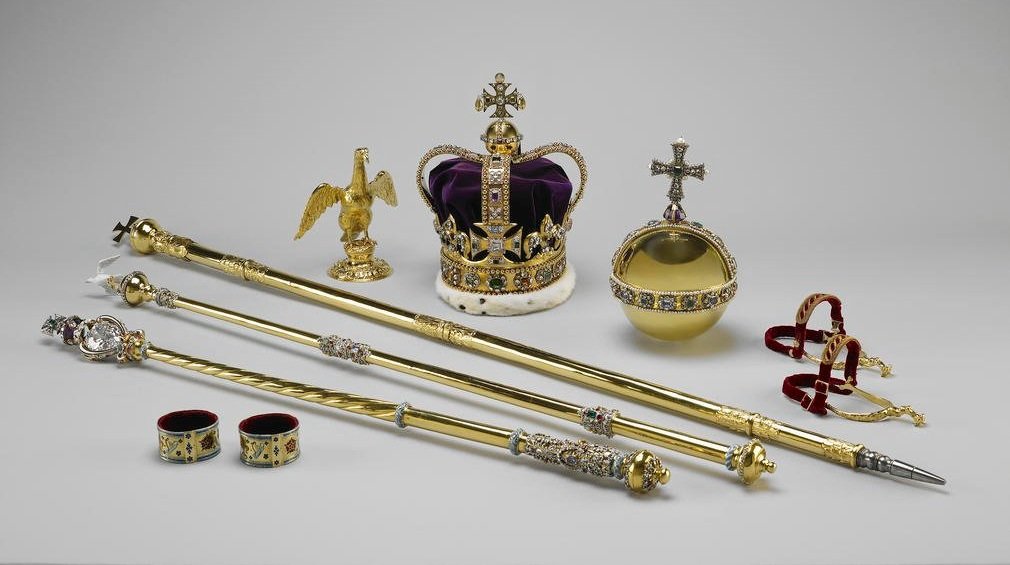Living in the UK: The Orb and the Sceptres
A Brief Introduction of Five of the Crown Jewels
In this image, you can see St. Edward’s Crown, the Orb, the Sceptres and the eagle-like Ampulla. St. Edward’s Staff (the longest sceptre in the image), the Spurs and the Armills (the bracelets) are also featured here. Image source: Royal Collection Trust / © His Majesty King Charles III 2023
Whatever your opinion of the monarchy, there's no denying that the upcoming Coronation of King Charles III will be a historic, once-in-a-lifetime moment for many. The historicity of the King's Coronation is not only because it is a rare occurrence, but also because it is a ceremony that reflects the inheritance and the continuation throughout the long history of the British Monarchy. In this ceremony, many symbolic objects have already been passed down and used over hundreds of years. These objects have different meanings, and they reflect people's understanding of monarchical power, as well as the expectations for and the responsibilities of the monarch.
In this issue, we will introduce five of the Crown Jewels (Coronation Regalia) that will play an important role in the King's Coronation, their brief histories, and what they symbolise. So that if you watch the live broadcast of the Coronation this Saturday, you will be able to see what different parts of this Ceremony mean both historically and culturally.
Priesthood and Kingship: The Chrism oil
Among the Crown Jewels, there is a… golden flask and a spoon? Actually, this “flask” (the Ampulla) that looks like an eagle was made for Charles II’s coronation in 1661. The Coronation Spoon is much older - it is an artifact from the 13th Century that has survived till today, and is the oldest among all the Crown Jewels. On this Saturday, this Ampulla will contain the Chrism oil which will be used to anoint the monarch.
Anointing is a tradition dating back to the time of the Old Testament when Israeli kings and priests were anointed to be made holy and set apart for their temporal or spiritual offices. In the mediaeval times, this holy sacrament confirmed the monarch’s divine appointment by God to rule over the land. While British monarchs no longer rule by divine right, anointing is still part of the Coronation rites as the monarch will still be installed as the head of the Church of England.
During the anointing, the archbishop will pour the Chrism oil, which is made from olives harvested near Jerusalem, from the Ampulla onto the Coronation Spoon. He will then anoint the monarch in the form of a cross on his head, breast and hands. This part of the Ceremony will be shielded from public eyes by the Anointing Screen.
After the anointing, the monarch will be vested with the Supertunica, a form of priestly robe, on the simple garment (Colobium Sindonis) that he wears at the anointing, signifying how the monarch has been consecrated in the service of God.
A Christian King: The Sovereign's Orb
After the anointing, the monarch will be presented with various Crown Jewels that represent the duties and responsibilities of a king or a queen. The Sovereign's Orb is a golden ball made in the 17th century with a cross on top. The sphere represents the world, and the cross on the sphere represents the sovereignty of Jesus Christ over the world. This symbol (globus cruciger in Latin, meaning "orb and cross") was in use as early as the Fifth Century AD. It was also often featured on coins, portraits, and sceptres during the Middle Ages. Traditionally, it represents both the authorities of God and the King. During the Coronation, the Archbishop of Canterbury Justin Welby will place the Orb in the King's right hand, representing how kingship is given by God and reminding the monarch that he will be ruling the country on behalf of God.
Power and Justice: The Sovereign’s Sceptre with Cross
The Sovereign's Scepter with Cross is a symbol of the British monarch as the head of state and symbolises his or her power to govern the country. Made in 1661 together with the Sceptre with Dove for the Coronation of Charles II (1630-1685 AD), its most well-known feature is the Cullinan I (also known as the Great Star of Africa), the second largest cut diamond in the world, which was added onto the Sceptre in 1901.
Equity and Mercy: The Sovereign’s Sceptre with Dove
The Sovereign's Scepter with Dove (traditionally known as the Rod of Equity and Mercy) represents the spiritual duties of the Sovereign. On the top of it is the Holy Spirit, symbolised by an enamel dove with outstretched wings. In the Coronation ceremony, only after the monarch is presented with the Sceptre and the Rod, and is holding both in his or her hands, will the Archbishop crown the monarch with St. Edward’s Crown.
Lineage and Tradition: St Edward’s Crown
St. Edward's Crown is the coronation crown of the British monarch. It is a golden crown made for the Coronation of Charles II in 1661, following the style of the crown of a legendary King, Saint Edward the Confessor (1003-1066 AD). Later British monarchs such as George V (crowned in 1911), George VI (1937), and Queen Elizabeth II (1953) all wore this crown for their Coronations, which were definitely no easy feats, as this crown weighed more than 2kg.
After the Coronation, King Charles III will wear the Imperial State Crown made in 1937 before joining the Coronation Procession to Buckingham Palace. The Imperial State Crown is mostly used for the State Openings of Parliament, and, in this instance, the Coronation Procession.
In fact, the Crown Jewels representing the British Monarchy are not limited to the above five items. Others include the queen's crowns, the queen's sceptres, the king's and the queen’s rings, spurs, Armills (a form of bracelets), and four swords representing kingship, the armed forces, faith and mercy, etc. These objects are usually kept in the Tower of London, and are rarely seen except for exhibitions. Therefore, if you are interested in British history and its royal traditions, don't miss this opportunity to have a look when all of them are gathering in public view at the same time this Saturday!
In addition to the religious significance contained in some of the Royal Regalia, the Coronation, which will be held in Westminster Abbey, is also a Christian ceremony with long histories before it. The liturgy, prayers and music, and even the order in the presentation of the Regalia, all have interesting meanings. They all reflect the culture and history of the British Monarchy, as well as the ancient and contemporary understandings of monarchy, and, and what people expect the monarch to be like.
If you want to look more deeply into the histories and culture, you can find the entire process of the ceremony, as well as brief explanations of the Crown Jewels, in the Coronation Liturgy on the Church of England website. The Westminster Abbey website also offers a brief introduction about the history and procedures of the Coronation. As for details about the entire programme of the Coronation Day, you can also find it in this very detailed report by BBC.

